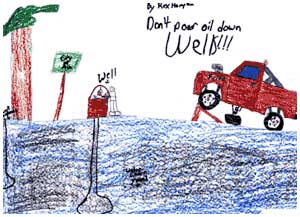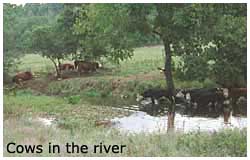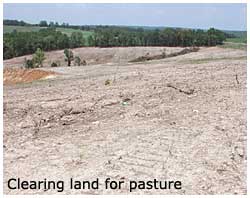|
 
Earth  Environmental
Education Environmental
Education  What Is Nonpoint Source Pollution?
What Is Nonpoint Source Pollution?
What is nonpoint source pollution?
|
|

Drawing by Rex, Ava Elementary School |
Nonpoint source (NPS) pollution comes from so many
sources that one point cannot be identified.
Rainfall or melting snow flows over and into the ground. It picks
up and carries away both natural and human-made pollutants.
These pollutants end up in lakes, rivers, wetlands, and even our
underground sources of drinking water.
|
| What
causes nonpoint source pollution?
We all play a part. Nonpoint source pollution comes
from a wide variety of human activities on the land. Each of us
can contribute to the problem without even realizing it.
|
|
Nonpoint source pollutants include:
Excess fertilizers, herbicides, and insecticides
from farms, homes and towns
Oil, grease, and toxic chemicals from cars and
the roads and parking lots they use
Sediment and erosion from construction sites,
pasture and crop lands, and eroding streambanks
Salt from irrigated land
Acid drainage from abandoned mines
Bacteria and nutrients from livestock, pet wastes,
and faulty septic systems
|

|
 |
|
What are the
effects of these pollutants on our waters?
Nonpoint source pollution is the leading remaining
cause of water quality problems. The effects of nonpoint source
pollution are hard to measure. However, we know that these pollutants
have harmful effects on drinking water supplies, recreation, fisheries,
and wildlife.
|
|
 What
can we do about nonpoint source pollution? What
can we do about nonpoint source pollution?
|
|

